Desert landscapes, rainbow mountains, cultural villages, and some of the best food in Argentina, Salta and Jujuy have it all.
This post is a breakdown of our 9 day Northwest Argentina road trip through Salta and Jujuy, one of the most breathtaking Argentina road trips.
May it inspire your own northwestern adventure.
NOTE: There has been damage to some of the routes mentioned in this itinerary (updated 2024). I highlight them below above the map of my route and in relevant parts of the itinerary. Keep this is mind when planning your route if traveling in the immediate future.

QUICK NOTE: This post contains affiliate links and Sol Salute may receive a commission for purchases made through these links, at no extra cost to you.
Argentina Road Trip to Salta & Jujuy
We went on an epic 9-day Argentina road trip across Jujuy and Salta and I don’t think I’ve ever seen anywhere so beautiful.
This post is a breakdown of our Jujuy and Salta road trip itinerary: the route we drove, where we stayed as well as options if you have more time to spend than we did!
Map of our Jujuy & salta Road Trip
ROUTE UPDATE 2024: The route highlighted below is a loop. Not knowing any better and having done very minimal research, I blindly followed Google Maps and luckily had no issues with the roads. This was helped by the fact that we traveled in winter to avoid rainy season.
Summer months can bring storms and storms and cause landslides and road closures.
This summer (February 2024) there have been some issues with roads. I highly recommend checking with your accommodation in advance before booking any routes, to be sure of the state of the roads.
It’s also always a good idea to check the day before you drive if you’ll be going on a mountain pass (like from the salt flats to San Antonio de los Cobres or from there up the Abra del Acay, or up to the Hornocal, etc) to see how the roads are. Checking with the police station is recommended.
As of winter (July 2024) just about all of the damage on main roads (like to the Salt Flats) has long been fixed. But the Abra del Acay mountain pass is high risk and although we did it (like fools), I don’t recommend it now, even more so with storm damage.
NOTE: If you see any updates to the routes while on the ground in Salta or Jujuy, please leave a comment to let me and other travelers know. Whether it’s a road closure or a closure mentioned here that has been fixed. Thanks!
When to visit Jujuy & Salta
-
January and February bring crowds and rain. If you want to do a road trip here, avoid driving yourself during the rainy season. A lot of roads become impassable, mountain passes such as Abra del Acay would be out of the question. Fording the creeks (now rivers) that flow over the roads on your way to Iruya will require a lot of skill (more than I have!). January and February are summer holidays for Argentina and while this area is off the beaten track for foreigners, it isn’t with the locals. It will be very crowded.
-
Semana Santa (the week leading up to and including Easter) is very busy. This is an extremely devout area of the country and it’s famous for its Easter celebrations. If you’re visiting for Semana Santa, reserve ahead of time to be sure you get a bed. The same goes for Carnival.
- We went in May and the weather was perfect. We were blessed with sunny days every day. The afternoons were ideal at 17-20 degrees Celsius (60-70’F), we were in shorts and t-shirts more afternoons. At night, temperatures plunged and we were bundled up in sweaters. I loved the cold nights in the mountains with their hearty, warm food and cozy, adobe homes.
How to get to Salta
You’ll need to fly from Buenos Aires to either Jujuy or Salta.
We flew into Martín Miguel de Güemes International Airport in Salta (airport code: SLA) and drove straight to Jujuy from there.
If you’re flying into Salta, check rates here for rental cars from Salta.
It would have made more sense for our itinerary to fly into Jujuy’s airport. However, it was cheaper to fly into Salta.
The drive from Salta to Jujuy added only a couple of hours to our day and it really was a beautiful drive through a lush, green valley.
The Jujuy airport is Gobernador Horacio Guzmán International Airport in San Salvador de Jujuy (airport code: JUJ). If you’re flying to Jujuy, check car rental rates here.
If you’re backpacking in Argentina, this is a common route to connect Bolivia to Argentina.
You’d cross from Bolivia into Argentina in La Quiaca, then work your way south through Jujuy then Salta, and onwards (or vice-versa).
This exact itinerary wouldn’t suit that route (since it’s a loop through the region beginning and ending in Salta) but the advice on the region still holds.

Argentina Road Trip: Tips & Advice
Enjoy the drive
If you’re focused on the destination and not enjoying the journey, you’re missing the point.
Every bit of highway had something new to offer.
The landscapes changed drastically throughout the drive, the small towns we visited along the way, the wildlife (llamas!), and more.
Enjoy your time on the road, don’t rush through it to get to your destination. This is your destination.
Do you need a 4×4?
It would be helpful but we didn’t have one. I rented the cheapest option available, as I tend to do, and we were fine.
But would it have been easier with a 4×4? YES.
A lot of the roads we took were dirt roads and our little Chevy Joy didn’t have great traction.
We also had to cross so many creeks that ran over the road that I lost track, and they were scary with our little car.
If there’d been more rain recently, it would have been impossible.
Don’t pick up hitchhikers
We actually didn’t see any, but a neighbor offered us this piece of advice that was given to him by a border control agent while he was driving in Jujuy.
The agent said many of the young women you see hitchhiking at drug mules coming into the country from Bolivia.
They’ll hitch a ride, but if you go through one of the regular police checks, they’ll leave the drugs in your car and jump out, leaving you to take the blame.
I’m not sure if this is accurate, but it wouldn’t hurt to keep in mind! We’ve all seen how Brokedown Palace ended.
Don’t look at the kilometers, ask how long it will take
Google Maps may tell you an hour and a half, but a local will tell you four hours.
Listen to the locals.
A lot of the roads are very hard to drive, through mountain passes we were sometimes brought to a 20 km/h crawl.
Should you bring a car seat?
Like everywhere, rental agencies will rent you a car seat for a daily surcharge. The charge is very affordable.
Also keep in mind that it will probably be old and very worn in, but I’ve never had an issue with the seats given to us.
Make sure to arrange it ahead of time or travel with your own car seat.

Keep the gas tank full
If you’re embarking on a long drive (say from Tilcara to Cachi like we did in one long day), fill your tank before you leave town.
There are long stretches between a lot of the cities and you may not see a gas station for quite a while.
Bring toilet paper
I found the probability of TP in public bathrooms to be about a 50/50 shot, so just keep a pack of tissues in your bag, you’re welcome.
Know how to change a tire
There’s a huge chance you’ll pop a tire. Everyone joked about it before we left. I felt that cocky “it’ll never happen to me” attitude everyone gets before it happens to them.
We popped a tire. Check your rental’s spare when you pick up the car, there’s a big chance you’ll need it.
You can bring the deflated tire to a tire shop (gomeria) in the next town you visit for a quick patch (parche).
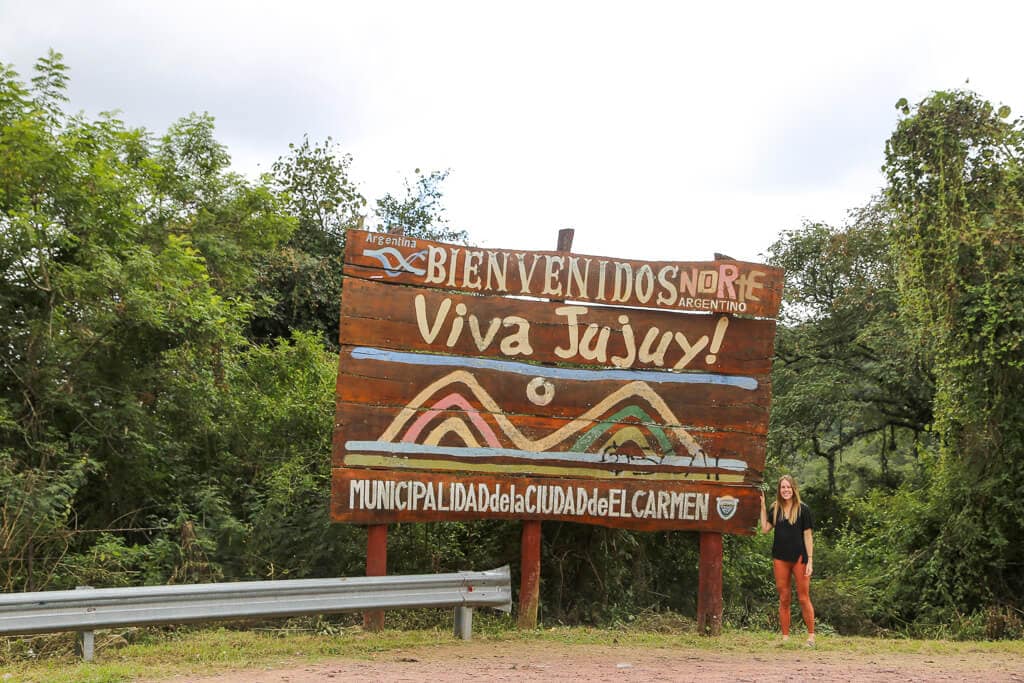
Our 9 Day Itinerary: Road Trip Salta & Jujuy
We flew into and out of the city of Salta. I chose to hit the ground running and save the city for our last day.
This also gave us some lee-way on getting back into town and to the airport should any car trouble cause delays in our trip.
We took the first flight out of Buenos Aires, landing at 10 am. We got our car and hit the road to Jujuy.
Day 1: Drive from Salta to Tilcara
The drive from Salta to Jujuy was very green and lush. I had this image in my head Salta being part of a large desert and didn’t expect this green forest!
We took the old Ruta 9 and it was a challenging drive.
The road isn’t wide enough for one car to fit comfortably in its lane.
There are also countless hairpin turns (a recurring theme for this trip).
We came across cows, goats and one large pig just chilling on the road more than once, so going slow was a must.
But why rush?
The views were gorgeous and worth taking your time. It took us about 5-6 hours, but we stopped twice on the way, for lunch and for a look around Purmamarca.

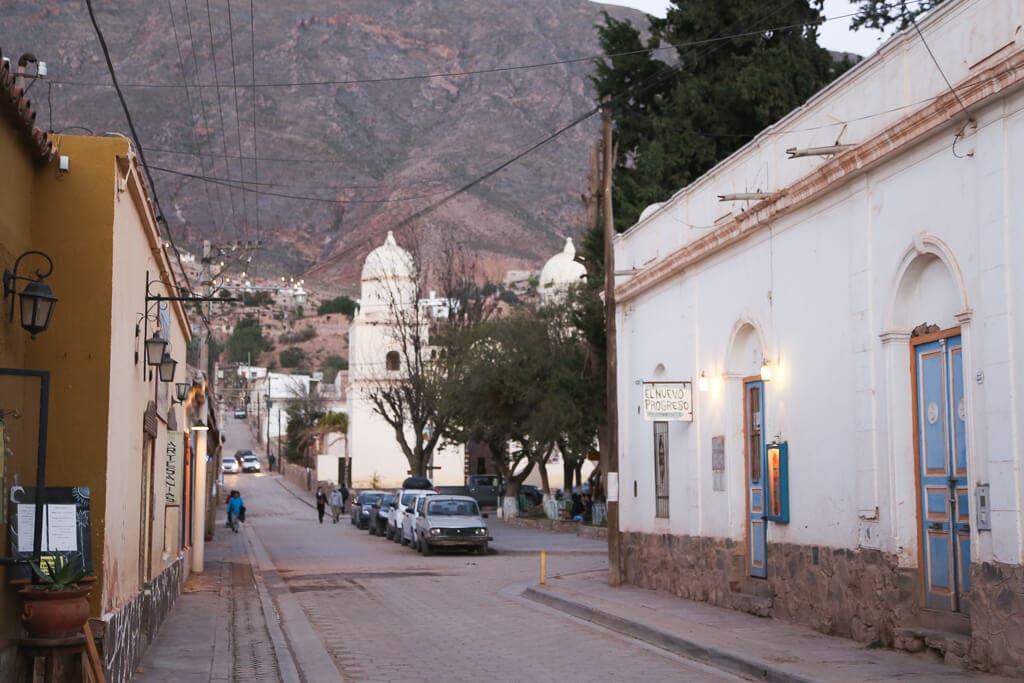
3 Days in Jujuy
We spent 3 nights in Tilcara, exploring Jujuy. We chose Tilcara as our base for Jujuy.
It’s a larger city (as in, the largest of the small villages). It didn’t feel as touristy as Purmamarca, as there were a lot of locals living here.
We stayed at an amazing Airbnb similar to this one.
It had a panoramic view of the town and the best balcony in town to watch the sunset over the nearby mountains.
Jujuy is a bit of the forgotten stepchild compared to Salta.
People often only dip their toes into Jujuy as day trips to the salt flats and Purmamarca.
Jujuy, however, is equally beautiful and very different than Salta. It deserves time, we only had three days in Jujuy, but 5 or 6 would have been ideal.

With 3 days in Tilcara, we were able to explore quite a bit.
We spent one day driving north to Humahuaca to see the 14 colored mountain (well worth the drive!), stopping in Uquia along the way for a hike to the Cerro de las 3 Señoras.
Read about the best hikes in Argentina here, including this one in Jujuy,
The next day we visited the smaller towns of Maimara and Purmamarca.
On our third and final day, we drove our next destination: Cachi (with a pit stop at the Salt Flats).

Option for 5 Days in Jujuy
If you have a few more days, I recommend adding Iruya to this itinerary (it would fit in easily after visiting Humahauca).
Iruya is a small village located further north of Humahuaca in the mountains.
Often described as being perched on the cliffs, I hear it’s one of the highlights of the region.
Unfortunately, we didn’t have the time to see Iruya.
The drive there is difficult and long so going for only one day isn’t recommended.
Spend at least two nights in Iruya to really experience it.
Then let me know how it went, I’m still dying to go!
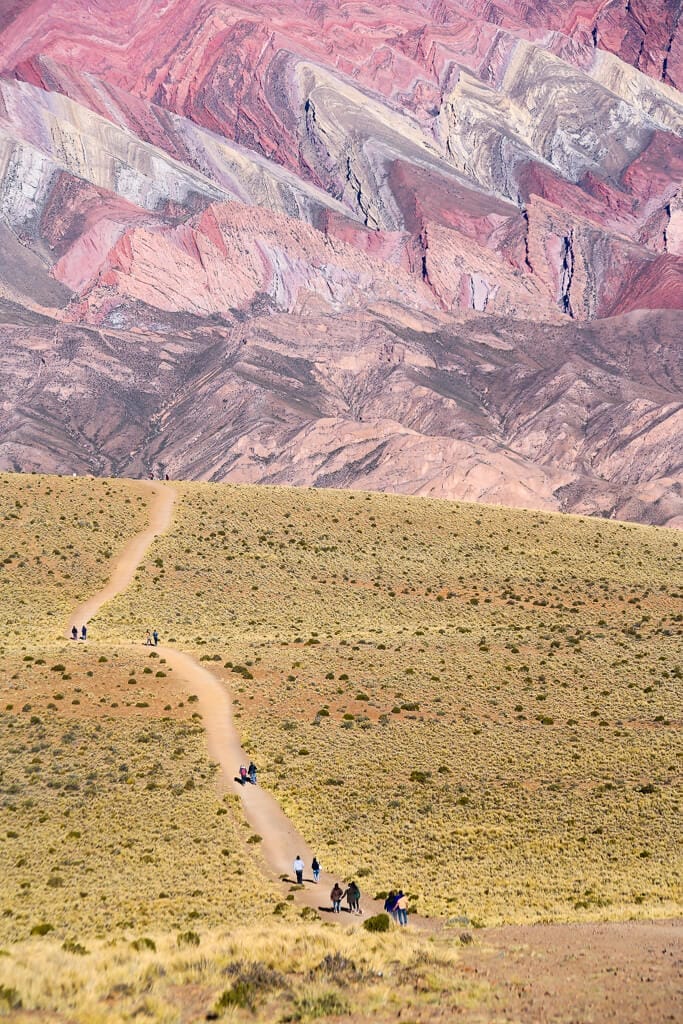

Day 4: Drive from Tilcara to Cachi
This day was our longest day, I vastly underestimated the time it would take to drive to Cachi from Tilcara.
We started the day by leaving at 7 am to visit the Salt Flats.
It took us about two and a half hours to get there (taking Hwy 52, passing Purmamarca).
The road was paved but there were a lot of hairpin turns that slowed us down quite a bit.
But I repeat, why rush? The views, enjoy the views!!

The Salt Flats: Salinas Grandes
The change in scenery from the mountain pass to the altiplano plains that surround Argentina’s Salt Flats is drastic.
We were like little kids seeing the white sea loom ahead, anxious to arrive. We spent about an hour and a half there, playing with perspective and taking fun photos.
Then we took the tour to drive to towards the center of the Salt Flats.
At around the equivalent of $10 US, why not?
A local guide hops in your car with you and gives you the history of the region and all the details about salt you could ever need.
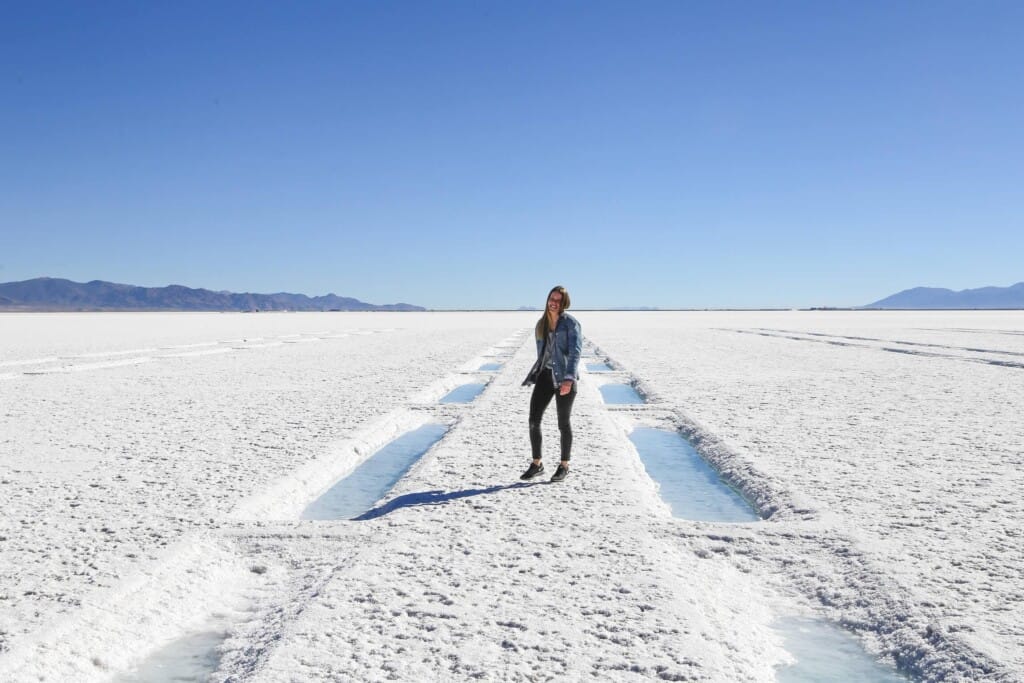
Llamas, Vicuñas & Guanacos
Cousins of the camel, you’re sure to see all three of these very different but very similar wild animals in Argentina near the salt flats.
How to tell the difference?
Check out the following three pictures out to help you out.
- Llamas are the biggest and have the most unkempt fur.
- Vicuñas are the daintiest, being slightly smaller, have slim necks, and very fine fur.
- Guanacos are similar in size to the vicuña, but darker in color. They’re dark brown with black faces.
- You won’t find Alpacas here. They were brought down by the Incas when they conquered the region, but not being native to the region, they died out.



Ruta 40: Salt Flats to San Antonio de los Cobres
Stretching across the entire country from north to south, the Ruta 40 is an infamous stretch of highway here in Argentina.
So I was very excited to drive part of it from the Salt Flats to Cachi.
Intersecting with the Ruta 52 at the Salt Flats, it seemed like an obvious route to take.
It’s a dirt road, or as it’s called here: ripio.
It was my vocabulary lesson of the trip, we drove a lot of roads that were “de ripio” and it was quite the challenge!

The picture above was at a particularly good stretch of road. Arriving in San Antonio, nearly 2 hours later, we saw an ominous sign: the road up ahead was under construction.
There were large tracks of road that was just sand.
Soft, deep sand. It was like trying to drive a sad little car with a weak engine across the softest beach you’ve ever seen.
Not. Easy.
But we made it, to what felt like a deserted town! And the road MUST be in great condition by now for your trip.
2024 UPDATE: A few readers have informed us that the road from San Antonio de los Cobres to Cachi is unsafe. If you travel this road in the future and have found it to be safe, please let me know! For now, I don’t recommend driving this route. The section of Ruta 40 from Cachi to Cafayate is fine.

San Antonio de los Cobres
San Antonio de los Cobres is what most mining towns seem to become, impoverished.
It felt abandoned, despite being a living town.
We arrived late and all the restaurants were closed, but a kind man opened his restaurant for us.
Bellies full of his delicious food and ears full of his very useful advice for the road ahead, we took off again.
Before leaving, he filled my thermos with hot water and gave me coca tea for the high altitude.
This man was my savior.
Option to add: Tren de los Nubes
I expected San Antonio to have more action because it’s home to the famous Tren de los Nubes. This is one of the most popular tourist attractions in Salta.
The train used to depart directly from Salta, and you’d spend the entire day on a rather slow train, finally reaching the stunning vistas it’s famous for.
Now, a bus picks you up in Salta (and is actually faster and more efficient than the previous train), and you board the actual Tren de los Nubes here in San Antonio. I decided to skip it.
If you’re driving through Jujuy, you’ll see plenty of gorgeous views, you don’t need to take an old, rickety train to see more (personal opinion).
If interested: Reserve your Tren de los Nubes excursion here.

Abra del Acay: San Antonio de los Cobres to Cachi
From here, Martin took over the wheel. From the sound of it, we had a rough drive ahead and I didn’t want any part of it.
We would be crossing the Abra del Acay mountain pass and we’d just found out we still had 4-5 hours of driving ahead, SURPRISE!
We continued on Ruta 40, over the mountains. It was the scariest drive of the trip, but also the most rewarding.
The views were incredible, we reached nearly 5,000 meters in altitude, and we saw guanacos!
The Abra del Acay is no joke and is not a safe drive, best with a 4×4. Especially after storm damage. BUT There is an alternate route: Take the paved highway 51 back to Salta. Ideally, spend the night in Salta and then drive to Cachi the following day. If I were to repeat this route today, I wouldn’t drive the Abra del Acay like we did in 2018.
If it’s raining, has snowed, or the road is unsafe (2024 update from a reader says it was not safe at their time of crossing), this will be your only option.

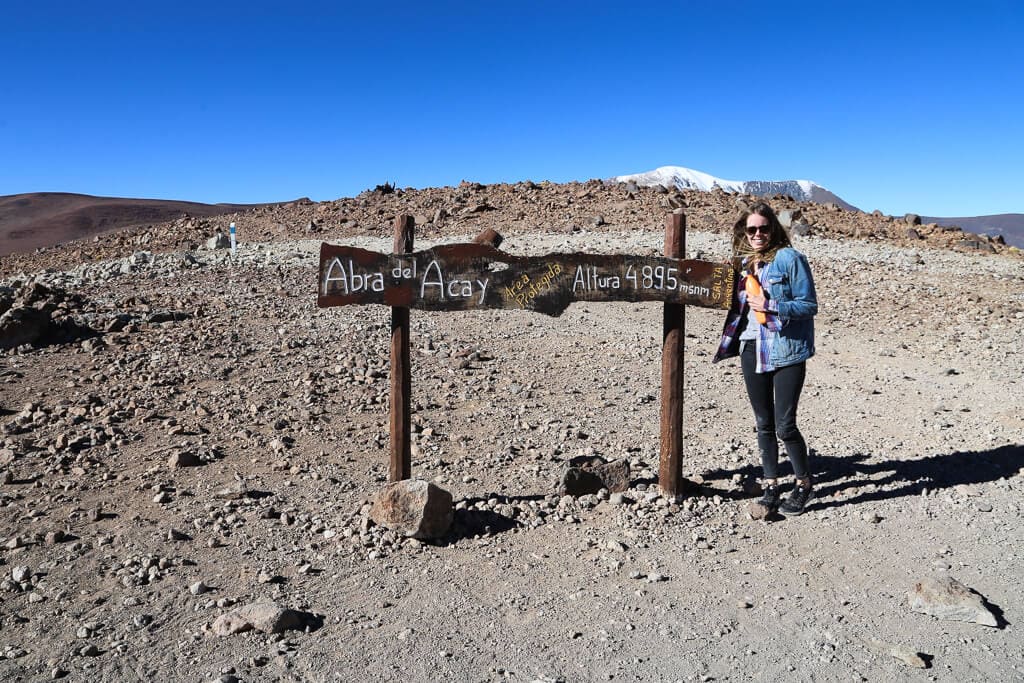
Leaving the Abra del Acay behind, we reached a valley.
The color of the earth changed from green to red as we drove along the Rio Calchaqui towards Cachi.
What impressed me so much about this region was how quickly the landscape would change.
In one day we’d seen the colorful mountains of Jujuy, white expansive salt flats, the plains of the Altiplano, green mountains, and the deep red valley of the Rio Calchaqui.
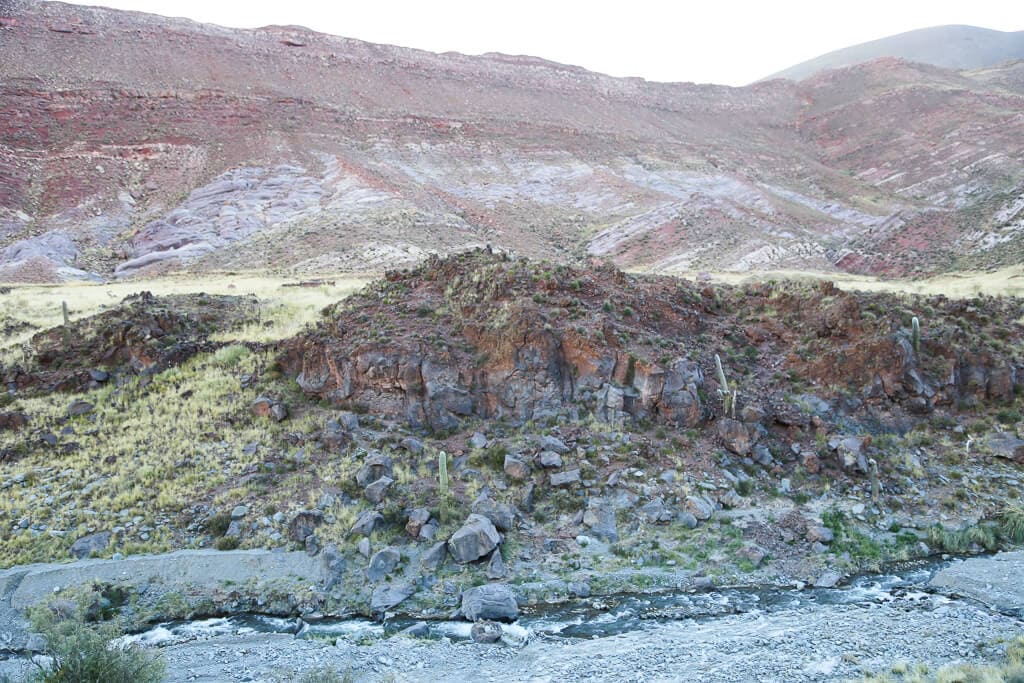

Flat Tire: It was inevitable
The sunset long before we finally arrived back “in civilization.”
Pulling into a police check in Payogasta, the first town we’d seen since San Antonio, we started to hear an odd sound.
The police had us roll our window down and cracked a joke about how they heard us before they saw us, “rough drive?”
Yep, the tire was completely deflated. How we made it this far before getting a flat is beyond me and a blessing.
We were lucky to be able to change it on a shoulder with the flashlights of the police, rather than on the edge of a cliff in the mountains.
Always find the silver lining.
Tire changed, we dragged our sore and tired bones to final few miles to Cachi.

Day 5: Drive from Cachi to Cafayate
Unfortunately, we only had time for the one night in Cachi. You could easily spend 3 days in Cachi.
This is where the Salta Wine Route begins, stretching all the way to Cafayate.
We spent the morning relaxing in Cachi while our tire was being patched up.
This slow start to the day was just what the doctor ordered after our marathon of a day the day before.
We finally rolled out of town at around 11 am, excited for another day of beautiful vistas.
Read more about Cachi, we have since returned for a longer stay and I wrote the following guides:
Where to Stay in Cachi
We spent our one night in Cachi at the Hosteria Villa Cardon.
My only regret is that we only had one night. I’d love to come back for at least three days to really enjoy the area and the hotel.
It was SO comfortable.
The traditional adobe structure was cozy and warm.
Breakfast was delicious and the woman who was working that night and the following morning was extremely friendly.
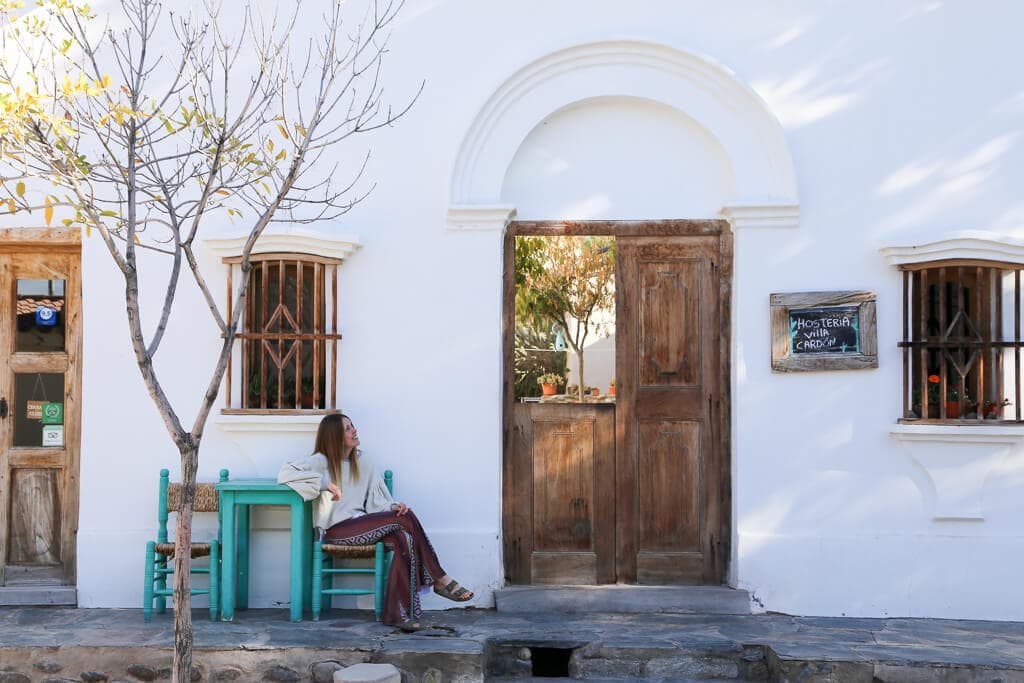

Lunch in Molinos
There are a few cute towns and wineries to stop at along the way, but we couldn’t due to our late start.
We drove through until our stomachs wouldn’t let us go further.
We pulled off the trusty Ruta 40 into the town of Molinos in search of empanadas.
If you’re looking for a pit stop, look no further than El Rancho de Manolo, just a block from the main square.
We ordered a plate full of empanadas, a humita en chala (like a tamale made out of sweet corn and cheese), and a salad for good measure.
I’m hungry just thinking about it.

While in Molinos, check out the church and the historical colonial home in front of the church.
While we’re at it, let’s just make it a rule that you visit every church in every small town you visit in Jujuy and Salta.
They were all beautiful, some dating as far back as the 1600’s.
Many are decorated with wood from the regional cactus. You haven’t seen churches like these before, I promise.
If you have the time, also visit Colome. It’s a world-renowned winery outside of Molinos.
We, unfortunately, didn’t have the time.
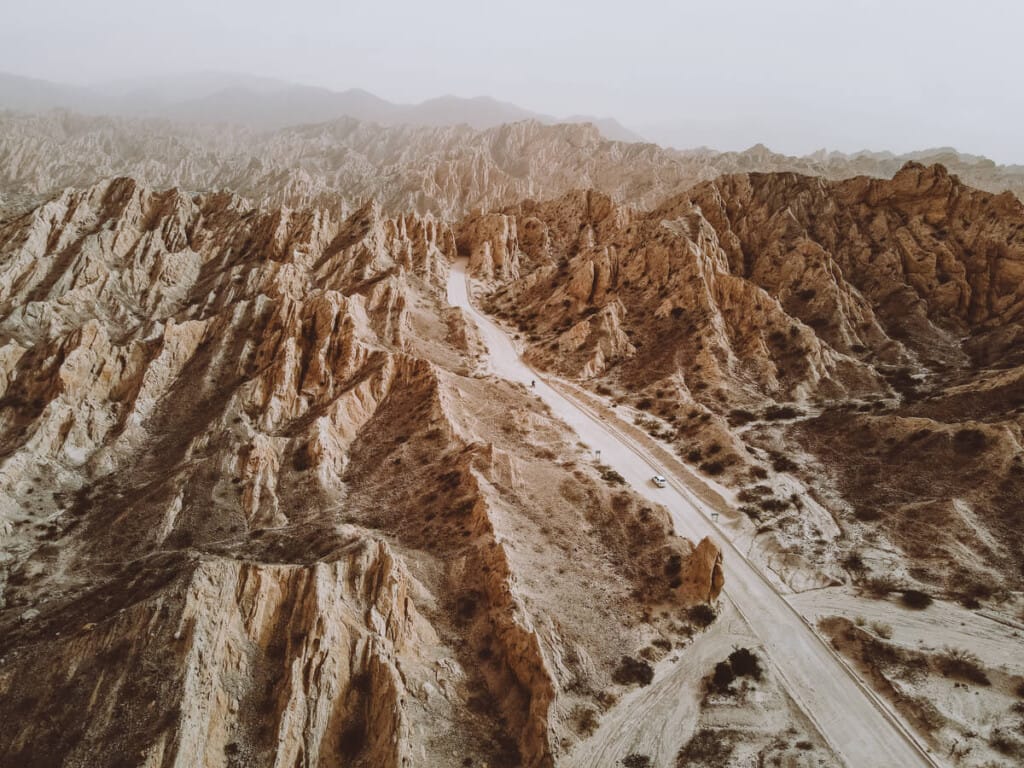
Quebrada de las Flechas
Bellies full, we returned to the Ruta 40 towards Cafayate. After passing the town of Angastaco, the landsc9ape changed abruptly from Earth to the Moon.
The Quebrada de las Flechas is a geographic formation that lasts for about 20 kilometers of highway and you’ll feel unsure of exactly what planet you’re on.
We pulled over at every viewpoint to take in the views.
I had never seen anything like this before! I really appreciated the signs that attribute Pachamama (Mother Earth) as the author of this masterpiece.
Stop at the Ventisquero (Wind Tunnel) view point, seen below.
There’s a short trail leading you up one of the formations for a panoramic view of the entire quebrada.
We brought alfajores for a snack at the top, never has a snack had a more beautiful view.
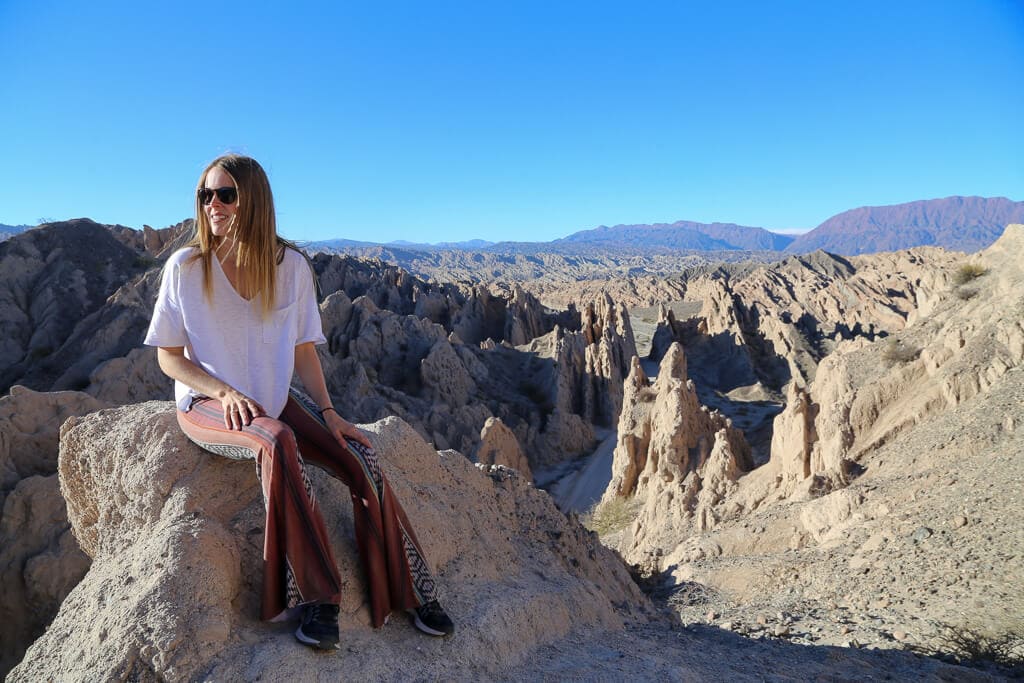

San Carlos
We had to pass by more wineries than I’d have liked (because ideally, I’d never pass a winery by), but we made the time for a quick visit to San Carlos.
Worth it. Another cute town, another beautiful church.
There’s a small antiquities museum with Pre-Colombian artifacts, just on the corner of the main square.
Next door to the museum is a cooperative shop selling local artisans work.
Shop for all of your souvenirs at these “cooperativas.”
They sell work directly from the artisans themselves, so you know your money is going to the right place. The quality is also much higher.
Be sure to check out the statue of a dog in the main square just across the street from the church.
He followed the villagers to the city of Salta on a pilgrimage and got lost there.
But not for long, he found his way home to San Carlos (a real-life Homeward Bound!).
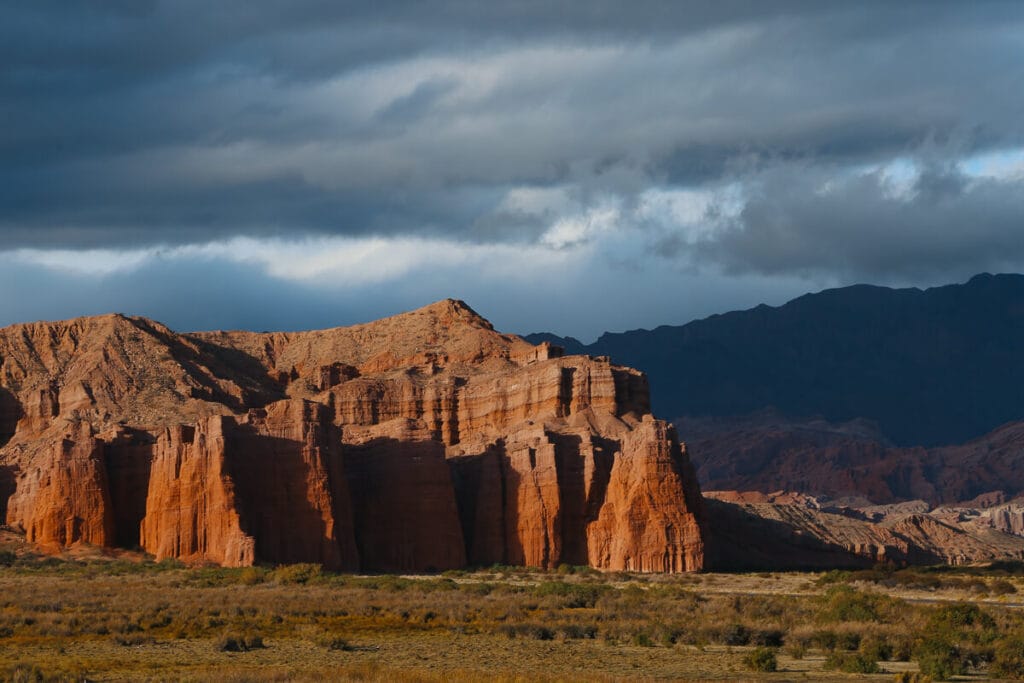
3 Days in Cafayate
After two long days on the road, three nights in Cafayate was just what we needed.
Saving this wine paradise for the last half of the trip was the right decision.
We spent our time eating and tasting the regions local delicacy: refreshing Torrontes wine.
The wineries in Cafayate are less strict than in Mendoza.
None required reservations and most could give us a tour and tasting whenever we just happened to show up. The tastings were also free, a happy surprise.
Read my article about the best wineries in Cafayate to plan your tastings.
We did get off our laurels one morning for a three-hour guided hike to the waterfalls.
I fell into the river, badly bruised my leg, and happily decided to stick with wine for the rest of this particular trip.


Where to stay in Cafayate
We have stayed in town at the Villa Vicuña Boutique Hotel (seen above). twice and I can’t say enough good things about this hotel.
The location is ideal, steps from the main square and there are even two wineries only 50 meters from their front door.
The Spanish-colonial home has been impeccably restored with a wonderful dining room for the buffet breakfast and beautiful patio to relax in after a long day of wine-tasting.
The staff are incredibly helpful, answering all of our questions, and the room itself was very comfortable.
I highly recommend it, check rates here.

Day 8: Drive from Cafayate to Salta
Saturday morning came and it was time for us to leave Cafayate.
I would have been happy with another day or two there but all good things must come to an end.
At least we had another beautiful drive ahead of us. And can I just say how happy we were to be driving on pavement again!
Highway 68 was a pleasure to drive after two days of the dirt and rocks of Ruta 40.
This drive took us about 6-7 hours but we stopped a lot (a lot), including a long lunch stop.
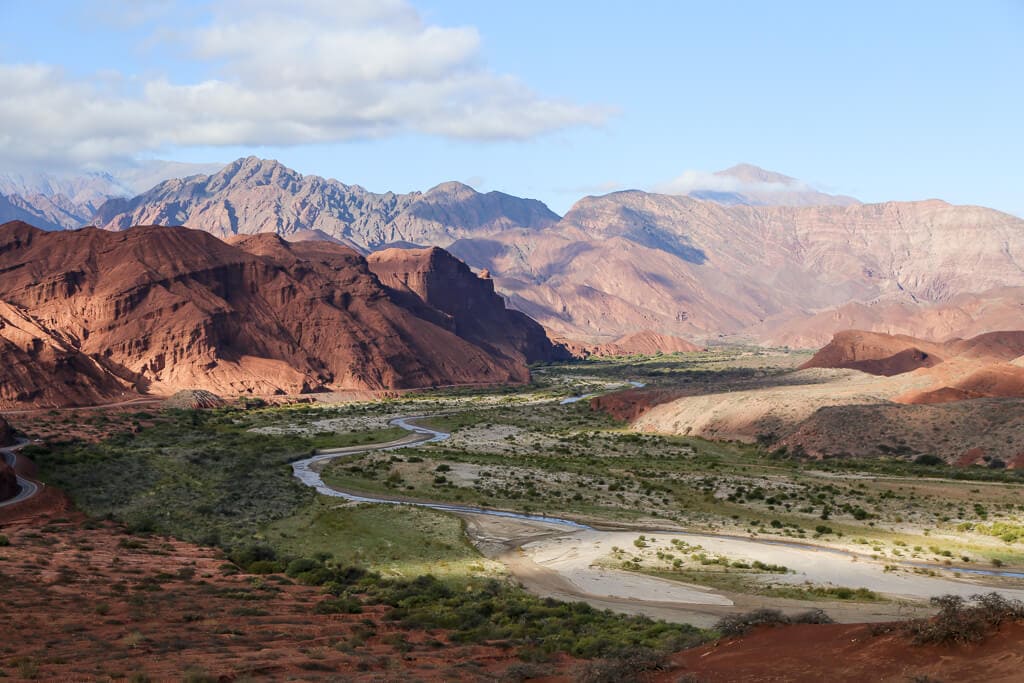
Quebrada de las Conchas
The drive from Cafayate to Salta is one I’ve heard about for years. And no wonder, what a beauty!
The Quebrada de las Conchas is one for the books.
If you happen to have more time in Cafayate, you can explore the Quebrada with a bike (most hotels, hostels, and tourist agencies rent them by the hour).
Lacking the time, we explored by car on our way to Salta. The dirt is a deep red and the mountains offer stunning formations.
Lots of pit stops were made and our jaws dropped nearly every time we turned a corner.
Read More: Complete Guide to the Quebrada de las Conchas
Valle de Lerma
I knew we were getting close to the city of Salta when the red dirt disappeared and the lush, green vegetation took over.
It surprised me how quickly the topography changed.
Red desert to lush forest, it happened so quickly I didn’t notice it happen until we were surrounded by green.
Reluctantly we were leaving nature behind and arriving in the city for our last night.
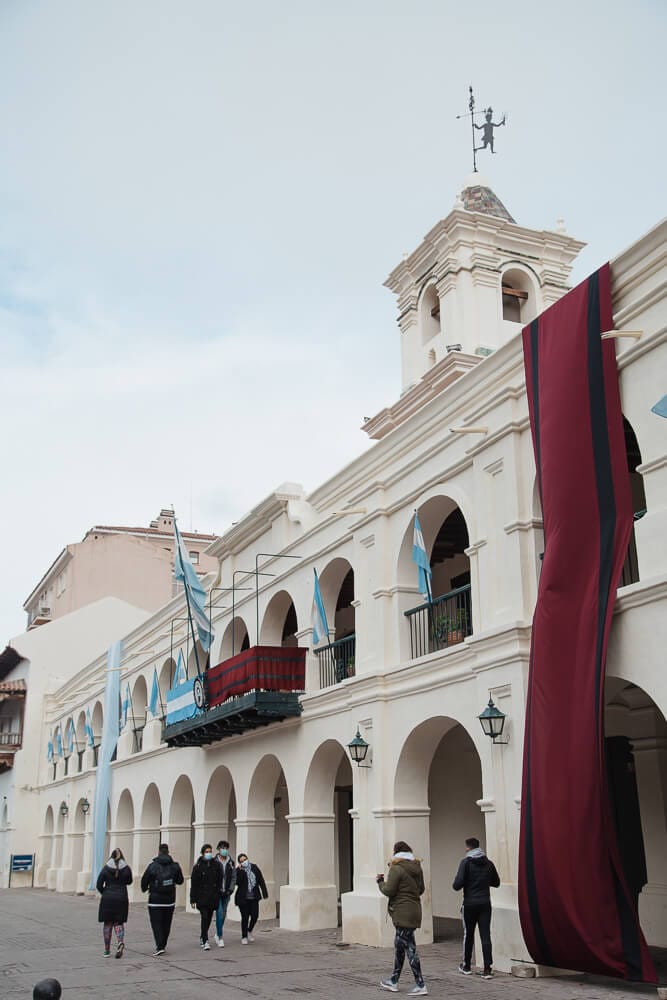

Salta (City)
It was disappointing to return to a city (albeit a small one) after being in such beautiful natural landscapes all week.
But at least Salta is a beautiful city.
We had one night and the following day to explore for our Sunday night flight back to Buenos Aires.
And to be honest, you don’t need any more time than this to see Salta.
We were able to see all the highlights at a relaxed pace and with time left over.
My main advice is if you’re tight on time, save that time for the towns like Cachi, Cafayate or the villages of Jujuy.
Allow a full day to see the Archeological Museum, the two main churches and to take the funicular up Cerro San Bernardo. It’s all you need.
Read Next: A One Day in Salta Itinerary


Where to Stay in Salta
On our most recent trip to Salta we stayed at the Villa Vicuña Boutique Hotel. It’s the same hotel as the one we stayed at in Cafayate (see that one here).
Villa Vicuña is impeccably decorated and feels luxurious while still being accessible. With only 12 rooms, you are guaranteed an intimate and quiet stay.
The location is unbeatable, less than 3 blocks from Plaza 9 de Julio, 1 block from Iglesia San Francisco, and within reach of Cerro San Bernardo.
You can walk everywhere you need to go. It is also steps from all of the main rental car agencies, making it easy to return your car at the end of the trip.
Argentina Travel Resources
- BOOK A CONSULTATION | I offer one-on-one travel consultations to help you plan your trip to Argentina. Pick my brain to get a local’s insight. Click here for more information.
- MY MAP | Buy my interactive map with 300+ pins to have access to the city as I see it. It is an invaluable resource. See more here about how it works.
- AIRPORT TRANSFERS | Having a driver waiting for you is ideal for a stress free arrival, Cesar and his team here is the best option for a driver from Ezeiza or Aeroparque, they are my go-to airport ride!
- TRAVEL INSURANCE | Always travel insured. Anything can happen anywhere and it is scarier and costlier in an unfamiliar country. SafetyWing’s Essential Plan covers unexpected travel and medical emergencies and even offers add-ons like electronics theft or adventure sports. It is the best if you’re coming on vacation. If you’re coming as a digital nomad or an extended stay, you need their Complete Nomad Plan which also covers routine check ups, maternity, mental healthcare and more. Read more: Health Insurance in Argentina
- PHONE PLAN | These days, traveling with data is essential. Especially in Argentina where everything is managed on Instagram and WhatsApp. I recommend this E-SIM card. It’s hassle-free and affordable, for more read how to get an Argentina sim card.
- ACCOMMODATION IN ARGENTINA | booking.com is the most common hotel site used in Argentina and it’s where you’ll find the most options.
- RENTAL CARS | I love using Discover Cars, it is a great platform to compare different rates and providers and I find they have responsive customer service.
- BUS TICKETS | Check Busbud for long distance bus routes and tickets.
- VPN | If you’ll be using a public WiFi connection and want to secure your data, I highly recommend using a VPN, I personally use and have had a good experience with ExpressVPN. I also use it to access Hulu and American Netflix from Argentina.
- FLIGHTS | Always check Google Flights and Skyscanner for flights to and within Argentina. Aerolineas Argentina is the local airline with the most routes. FlyBondi and Jetsmart are two budget airlines with dirt-cheap prices (but expect to pay for every add-on like luggage).
The Ultimate ARgentina Road Trip: Salta & Jujuy
These 9 days in Salta and Jujuy were the best trip I’ve ever had in Argentina (so far).
I was blown away by this area of the country.
It’s unlike no other part of Argentina, and actually, closer resembles Bolivia in landscape and culture.
The people were friendly, the food was delicious, and the wine was free-flowing. I will be back.


Thanks so much! I hope you love it 🙂
Thanks for reading 🙂 you’re right, it’s a 2 birds 1 trip situation!
This is amazing, Erin! Argentinian skies are such a glorious shade of blue and the landscape is magnificent all along the way. I can’t wait to visit South America and write about it!
Wow two things I’d love to do in one trip: go on a road trip and visit Argentina. I’m about it.
This is such an awesome, helpful guide! I am totally convinced to visit Argentina now – would love to take at least two weeks and see different parts of the country! 🙂
Thanks for reading! I hope you make it sometime, you’ll need at least two weeks, it’s such a huge country! There’s a lot to see
Your photos are so gorgeous! Amazing post. Crazy to think that these photos remind me so much of Arizona, but in a completely different country. I totally want to visit the salt flats!
Thanks for reading! I know, Northwest Argentina is so similar the American Southwest! I still haven’t been to Arizona or New Mexico but I’m dying to go!
I hope you can make it on this road trip one day, it was amazing!
The pictures from the road trip look amaaaazing! I just wanna follow your footsteps, and definentely not picking up any hitchhikers 😱
Dear Erin, thank you so much for this post and many others about Argentina! I was searching for information on the road trip around Salta and your post is just the best! I have already read many other posts of yours as well 🙂 They are exactly what I need for my trip to Argentina in October, thanks again!
I’m so glad to hear they’ve been helpful for your planning! You’re going to love Salta. It’s the most beautiful area in the country in my opinion!
Wow, what a helpful guide. Thank you so much for compiling all of this. We weren’t planning on doing Cachi and that western side because of the altitude – I have a borderline condition that isn’t meant to do well in altitude. Do you think that’s a good idea or should we go to Cachi no matter what?
Thanks!! It was a great trip! I think Cachi was gorgeous really, the altitude is 2,500 meters above sea level. Perhaps after some time at 1,500 in Salta first you’ll be acclimated a bit? I’d have liked more time, there are estancias and wineries in the area to visit.I heard that the Cuesta del Obispo is a stunning drive from Salta to Cachi but it has a higher altitude is 3400 meters, so be cautious with that. One place that would definitely be a problem is the 14 colored mountain in Humahuaca at over 4,000 meters, I was very dizzy!
Great blog! We intend to do the same trip in March.
One question: a successful road trip can be ruined by an unreliable car. I’ve heard mixed reports about the car rental places in Salta and wondered if you had any recommendations? Would you use the same guys you used for the last trip?
Thanks
Nick
Hi Nick!!
You’re right, it makes all the difference. I rented from Fit Rent a Car and I would definitely rent from them again. Note that they don’t have a booth in the airport but will pick you up outside, they were prompt and friendly and had no issues with us returning a filthy car. You can check rentals here:
https://www.rentalcars.com/AirportLandingPage.do?countryCode=&iata=SLA&affiliateCode=solsalute186&preflang=en
Great post! I’m planning on going in May. I grew ip in South America but never visit this area. A question. Did you go to Bolivia from there? Not sure how car rental would work when crossing borders. Also , my BF is American, any problems getting visa or crossing borders?
Hi Elena! We didn’t cross the border, but I would check directly with your car rental agency now before you arrive. A friend is crossing the border to Chile in a few months and the agency has to get the car certified or something before they get it. I’d let the rental agency know now and follow their instructions.
HI – thank you fro your great post. One question – where did you stay in Tilcara – it looks fantastic.
thank you
Jodie
http://www.fivebackpacksoneworld.com
Hello Jodie!!
It was a gorgeous airbnb, the link for it is in this post with more information about Tilcara and Jujuy:
https://www.solsalute.com/blog/3-day-itinerary-for-jujuy-argentina
Hey Erin,
Thanks for the info!
I am a South African travelling with my Argentinian GF to Salta to go watch our two teams battle it out on the Rugby field on Saturday. I was hoping to get to Salinas Grandes as well as see a few wine farms and taste some delicious Malbec. We land in Salta on Thursday evening, have the game on Saturday evening and then fly out on Monday morning, leaving two full days to see the salt flats and wine farms. I know our time is super short, but my question to you would be what is the best way to make the most of this time, considering we would need to spend Thursday, Saturday and Sunday nights in Salta City due to early/late flights and of course the main reason for our visit, the rugby match. Would you suggest hiring a car and if so where should we overnight on Friday night?
Your advise is much appreciated.
Regards,
Tyron
Hello Tyron!! Thanks for reaching out. Since the Salt Flats and the wineries in Cafayate are in opposite directions from each other, I recommend basing yourself all three nights in Salta city, which is more or less in the center. If I were you I’d rent a car so you can move freely and spend more time in Purmamarca on the way to the Salt Flats and along the Quebrada de las Conchas on the way to Cafayate. Enjoy your weekend and the rugby match!
Hey Erin,
I read a lot about corrupt police along the way that will charge you high fees even if you have all documents. Can you say something about that? How was your experience with the Poilce and the Police stops?
Thank you,
John
Hey Erin,
do you think that the trip is also possible in 4-5 days? We just want to see the natural scenery and not so much the villages along the way.
Thanks,
Peter
Hello Peter, I don’t think this loop is possible in 4-5 days. I’d recommend picking just Jujuy or Cachi/Cafayate. Or spend a day or two in each, using Salta city as your base.
We didn’t have any issue whatsoever with the police and I haven’t heard of that. We actually found the police to be fairly helpful when we had a flat tire.
Hi Erin,
This sounds like a fantastic tour.
I did see that you drove from the salt desert directly across the Puna to San Antonio de los Cobres. And that with a small “normal” car.
Was this possible without any problems? We are there at the beginning of November and wanted to drive this route. However, this was discouraged on the internet. How was your experience? We also only have a medium-sized car. Can you recommend it?
You also took Ruta 40 from San Antonio de los Cobres to Cachi over the Abra del Acay. The path is also said to be very impassable and not possible without a 4×4. Based on your experience, would you recommend driving this route in a “normal” car? We would love to drive both routes, but we are unsure about the road conditions.
Thanks a lot.
Robert
Hi Robert,
The road was hit or miss from the salt flats to San Antonio de los Cobres, at the entrance to the town they were working on the road and it was a literal sand pit, we skidded into town and I kind of don’t know how we did it. Who knows what it’s like now, that was 5 years ago. I’d say it’s doable though.
As far as Abra del Acay, I honestly wouldn’t want to do that road again in the dinky tin can we did it in. My stomach was in my throat the entire time and I am just grateful we didn’t cross paths with another car because it was NARROW and cliffside. It was a lot. You can always ask the local police in San Antonio de los Cobres the state of the road before starting the drive, if they say it’s impassable, listen to them and take the paved road back to Salta instead.
Love your content! My wife is from Argentina and we’ll be heading back for our 9th or 10th trip in March. Do you think this route is doable with only 6 nights? (Land Salta on Saturday and go, drive straight from Cafayate to the airport on Friday). Assuming not, what would you alter? We like to rough it but throw in some luxury as well! 🙂
Hi all!
Dont take the route 40 from san antonio de los cobres to cachi. A bridge broke down and the road is sooooo dangerous. We had to turn around en go al the way back. Later we found out It is “closed” but there is no sign.
Could you please update this articel for everyones safety?
Route 40 from cachi to cafayate is fine.
Thanks for the heads up! Put a note in the article with this update.
Hi! Thank you! I honestly wouldn’t do this route again in just 9 days, it was so rushed. 6 would be impossible.
I would do a modified version of this itinerary with no time in the city and see only Salta if you have 6 days, OR stay in Salta and head to Cafayate for a couple days, then return to salta and then up to Jujuy for a couple of days. But you’ll feel rushed with the 2nd option.
https://solsalute.com/blog/salta-road-trip-itinerary/
We ‘ve just got to Cafayate (April) after driving Purmamarca-Salinas Grandes-San Antonio via Ruta 51 to Salta then to Cachi then Ruta 40 to Cafayate.
The road from Salinas Grandes to San Antonio was..gravelly…with a few mini diversions into the fields to avoid muddy water traps. Was fine but a bit scary (we’ve previously got stuck in sand in Morroco!).
The Ruta 51 was AMAZING. We practically had the road to ourselves and the landscape was HUGE.
To be honest the ‘worst’ road was Ruta 40 Cachi-Cafayate. There is currently a diversion as they are tarmacing this bit of Ruta 40 so we had to go via another unpaved road with not very good visibility around corners etc so it was a very very rattley and bumpy and slow drive. Not my fave! But safe enough so just be prepared! Took us much longer than we expected.
Thanks for all the blog tips Erin! You’ll be pleased to know that there are now two more bodegas you can walk to from Cachi centre 🙂
This was so helpful, thank you for coming back to write this. Interesting that they’re paving that stretch of Ruta 40, that will be a game changer, my head is always wrecked after bumping along the ripio so long. But definitely inconvenient in the meantime..
Thank you for your article! I will set off in 2 weeks to Jujuy so this was extremely helpful information to plan my trip. I can only second that going to Cachi is not a good idea, it took friends of mine 10 hours last month!
A question to all the people who have maybe already done this trip: Do you have any recomendations for car rentals? I will fly to San Salvador de Jujuy and would like to rent a car from there.
Hi Julia, we are one week into our roadtrip in the Jujuy and Salta region. I highly recommend booking through Booking.
We found it to be the best deal as well as the most convenient.
We rented with CDO Rent a Car and got a brand new VW.
Hallo, zijn de wegen van de gehele roadtrip in september goed begaanbaar met een 4×4?
Hi, am reading your post with excitement and bated breath. My cousin and I (two women) will be doing this or something very similar in April 2025! May I ask, where/town did you stay between Tilcara and Cachi and just one night? Couldn’t quite pinpoint it. I’ll be sure to update afterwards with any new road info I get. Thank you so much for putting this gorgeous info out there.